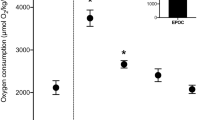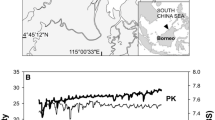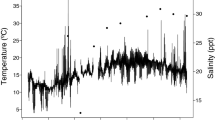Abstract
The bathymetric distribution of marine benthic invertebrates is likely governed by a combination of ecological and physiological factors. The present study investigates oxygen consumption and heartbeat rate in response to attempted feeding at 1, 100 and 150 atm in the shallow-water spider crab, Maja brachydactyla, from temperate European waters. No significant difference was evident between the resting heartbeat rate of specimens at 1 or 100 atm, which were 56 and 65 bpm, respectively (Mann–Whitney, U = 5382.0; n = 95, 98; p = 0.079). However, at 150 atm the resting heartbeat rate was significantly higher than that observed for 100 atm at 108 bpm (Mann–Whitney, U = 149.0; n = 45, 98; p < 0.001). At 150 atm, feeding was never observed and coupled with the elevated resting heartbeat rate; it is suggested by 150 atm continued survival is unfeasible. At 1 and 100 atm, feeding instigated a distinct increase in heartbeat rate, which remained elevated for over 30 h. This increase peaked within 1 h at 1 atm. At 100 atm, this required 4 h and postprandial oxygen consumption was significantly higher than at 1 atm (Kruskal–Wallis, H = 85.036; df = 2; p < 0.001). Elevated hydrostatic pressure is hypothesized to extend the duration and the total metabolic energy devoted to specific dynamic action. The metabolic requirements of feeding under hyperbaric conditions may even reach such a critical demand that feeding is entirely inhibited.






Similar content being viewed by others
References
Airriess C, Childress JJ (1994) Homeoviscous properties implicated by the interactive effects of pressure and temperature on the hydrothermal vent crab Bythograea thermydron. Biol Bull 187:208–214
Aronson RB, Thatje S, Clarke A, Peck LS, Blake DB, Wilga CD, Seibel BA (2007) Climate change and invasibility of the Antarctic benthos. Ann Rev Ecol Evol Syst 38:129–154
Avent RM (1975) Evidence for acclimation to hydrostatic pressure in Uca pugilator (Crustacea: Decapoda: Ocypodidae). Mar Biol 31:193–199
Balny CV, Mozhaev V, Lange R (1997) Hydrostatic pressure and proteins: basic concepts and new data. Comp Biochem Physiol 116A:299–304
Balny C, Masson P, Heremans K (2002) High pressure effects on biological macromolecules: from structural changes to alteration of cellular processes. Biochim Biophys Acta 1595:3–10
Bennett VA, Kukal O, Lee RE (1999) Metabolic opportunists: feeding and temperature influence the rate and pattern of respiration in the high Arctic wollybear caterpillar Gynaephora groenlandica (Lymantriidae). J Exp Biol 202:47–53
Benson B, Krause D (1984) The concentration and isotopic fractionation of oxygen dissolved in fresh-water and seawater in equilibrium with the atmosphere. Limnol Oceanogr 29:620–632
Brockington S, Clarke A (2001) The relative influence of temperature and food on the metabolism of a marine invertebrate. J Exp Mar Biol Ecol 258:87–99
Carefoot TH (1990) Specific dynamic action (SDA) in the supralittoral isopod, Ligia pallasii: identification of components of apparent SDA and effects of diety amino acid quality and content on SDA. Comp Biochem Physiol A 95:309–316
Childress JJ, Cowles DL, Favuzzi JA, Mickel TF (1990) Metabolic rates of benthic deep-sea decapod crustaceans decline with increasing depth primarily due to the decline in temperature. Deep Sea Res II 37:929–949
Corgos A, Freire J (2006) Morphometric and gonad maturity in the spider crab Maja brachydactyla: a comparison of methods for estimating size at maturity in species with determinate growth. ICES J Mar Sci 63:851–859
Cottin D, Shillito B, Chertemps T, Thatje S, Léger N, Ravaux J (2010) Comparison of heat-shock responses between the hydrothermal vent shrimp Rimicaris exoculata and the related coastal shrimp Palaemonetes varians. J Exp Mar Biol Ecol 393:9–16
Dahlhoff EP, O’Brien J, Somero GN, Vetter RD (1991) Temperature effects on mitochondria from hydrothermal vent invertebrates: evidence for adaptation to elevated and variable habitat temperatures. Phys Zool 64:1490–1508
Depledge MH, Andersen BB (1990) A computer-aided physiological monitoring system for continuous, long-term recording of cardiac activity in selected invertebrates. Comp Biochem Physiol A 96:473–477
Distel DL, Baco AR, Chuang E, Morrill W, Cavanaugh C, Smith CR (2000) Do mussels take wooden steps to deep-sea vents? Nature 403:725–726
Elderfield H, Ganseen G (2000) Past temperatures and δ18O of surface ocean waters inferred from foraminiferal Mg/Ca ratios. Nature 405:442–445
Feder ME, Hoffman GE (1999) Heat-shock proteins, molecular chaperones, and the stress response: evolutionary and ecological physiology. Annu Rev Physiol 61:243–282
Frederich M, Pörtner HO (2000) Oxygen limitation of thermal tolerance defined by cardiac and ventilatory performance in spider crab, Maja squinado. Am J Phys 279:1531–1538
Hall S, Thatje S (2009) Global bottlenecks in the distribution of marine Crustacea: temperature constraints in the biogeography of the family Lithodidae. J Biogeogr 36:2125–2135
Heinemann SH, Conti F, Stühmer W, Neher E (1987) Effects of hydrostatic pressure on membrane processes: sodium channels, calcium channels, and exocytosis. J Gen Physiol 90:765–778
Herreid CF II (1980) Hypoxia in invertebrates. Comp Biochem Physiol A 67:311–320
Hill BJ (1976) Natural food, foregut clearance-rate and activity of the crab Scylla serrata. Mar Biol 34:109–116
Jaenicke R (1983) Biochemical processes under high hydrostatic pressure. Naturwissenschaften 70:332–341
Jain KK (1994) High-pressure neurological syndrome (HPNS). Acta Neurol Scand 90:45–50
Jannasch HW, Taylor CD (1984) Deep-sea microbiology. Annu Rev Microbiol 38:487–510
Jobling M (1992) Bioenergetics: feed intake and energy partitioning. In: Rankin JC, Jensen FB (eds) Fish ecophysiology. Chapman and Hall, London, pp 1–44
Kaye JZ, Baross JA (2004) Synchronous effects of temperature, hydrostatic pressure, and salinity on growth, phospholipid profiles, and protein patterns of for Halomonas species isolated from deep-sea hydrothermal-vent and sea surface environments. Appl Environ Microbiol 70:6220–6229
Lannig G, Bock C, Sartoris FJ, Pörtner HO (2004) Oxygen limitation of thermal tolerance in cod, Gadus morhua L. studied by magnetic resonance imaging and on-line venous oxygen monitoring. Am J Phys 287:902–910
Legeay A, Massabuau JC (2000) Effect of salinity on hypoxia tolerance of resting green crabs, Carcinus maenas, after feeding. Mar Biol 136:387–396
MacDonald AG (1972) The role of high hydrostatic pressure in the physiology of marine animals. Symp Soc Exp Biol 26:209–231
MacDonald AG, Teal JM (1975) Tolerance of oceanic and shallow water Crustacea to high hydrostatic pressure. Deep Sea Res II 22:131–144
McCue MD (2006) Specific dynamic action: a century of investigation: a review. Molec Integr Physiol A 144:381–394
McGaw IJ (2005a) Does feeding limit cardiovascular modulation in the Dungeness crab Cancer magister during hypoxia? J Exp Biol 208:83–91
McGaw IJ (2005b) Prioritization or summation of events? Cardiovascular physiology of postprandial Dungeness crabs in low salinity. Physiol Biochem Zool 79:169–177
McGaw IJ (2006) Feeding and digestion in low salinity in an osmoconforming crab, Cancer gracilis, I. Cardiovascular and respiratory responses. J Exp Biol 209:3766–3776
McGaw IJ, Reiber CL (2000) Integrated physiological response to feeding in the blue crab Callinectes sapidus. J Exp Biol 203:359–368
Menzies RJ, George RY, Rowe GT (1973) Abyssal environment and ecology of the world ocean. Wiley Interscience, New York
Mestre N, Thatje S, Tyler PA (2009) The ocean is not deep enough: pressure tolerances during early ontogeny of the blue mussel Mytilus edulis. Proc Roy Soc B 276:717–726
Mickel TJ, Childress JJ (1982) Effects of temperature, pressure, and oxygen concentration on the oxygen consumption rate of the hydrothermal vent crab Bythograea thermydron (Brachyura). Phys Zool 55:199–207
Mozhaev VV, Heremans K, Frank J, Masson P, Balny C (1996) High pressure effects on protein structure and function. Proteins Struct Funct Bioinf 24:81–91
Murray TF, Siebenaller JF (1987) Comparison of the binding properties of A1 adenosine receptors in brain membranes of two congeneric marine fishes living at different depths. J Comp Physiol B 157:267–277
O'Brien J, Dahlhoff E, Somero GN (1991) Thermal resistance of mitochondrial respiration: hydrophobic interactions of membrane proteins may limit thermal resistance. Phys Zool 64:1509–1526
Peck LS (1998) Feeding, metabolism and metabolic scope in Antarctic marine ectotherms. In: Pörtner HO, Playle R (eds) Cold ocean physiology. Cambridge University Press, Cambridge, pp 365–390
Peck LS, Webb KE, Miller A, Clark MS, Hill T (2008) Temperature limits to activity, feeding and metabolism in the Antarctic starfish Odontaster validus. Mar Ecol Prog Ser 358:181–189
Pörtner HO (2001) Climate change and temperature-dependent biogeography: oxygen limitation of thermal tolerance in animals. Naturwissenschaften 88:137–146
Ravaux J, Gaill F, Le Bris N, Sarradin P-M, Jollivet DB, Shillito B (2003) Heat-shock response and temperature resistance in the deep-sea vent shrimp Rimicaris exoculata. J Exp Biol 206:2345–2354
Robertson RF, Meagor J, Taylor EW (2002) Specific dynamic action in the common shore crab, Carcinus maenas (L.) in relation to acclimatization temperature and the onset of emersion response. Biochem Physiol Zool 75:350–359
Robinson NJ, Thatje S, Osseforth C (2009) Heartbeat sensors under pressure: a new method for assessing hyperbaric physiology. High Pressure Res 29:422–430
Sébert P, Theron M, Vettier A (2004) Pressure and temperature interactions on cellular respiration: a review. Cell Mol Biol 50:491–500
Shillito B, Jollivet D, Sarradin P-M, Rodier P, Lallier F, Desbruyères D, Gaill F (2001) Temperature resistance of Hesiolyra bergi, a polychaetous annelid living on deep-sea vent smoker walls. Mar Ecol Prog Ser 216:141–149
Somero GN (1990) Life at low volume change: hydrostatic pressure as a selective factor in the aquatic environment. Am Zool 30:123–135
Somero GN (1992) Adaptations to high hydrostatic pressure. Annu Rev Physiol 54:557–577
Somero GN (2005) Linking biogeography to physiology: evolutionary and acclimatory adjustments to thermal limits. Front Zool 2:1–9
Soofiani NM, Priede IG (1985) Aerobic metabolic scope and swimming performance in juvenile cod, Gadus morhua L. J Fish Biol 26:127–138
Stillman JH, Somero GN (2000) A comparative analysis of the upper thermal tolerance limits of eastern Pacific porcelain crabs, genus Petrolisthes: influences of latitude, vertical zonation, acclimation, and phylogeny. Physiol Biochem Zool 73:200–208
Thatje S, Anger K, Calcagno JA, Lovrich GA, Pörtner HO, Arntz WE (2005a) Challenging the cold: crabs reconquer the Antarctic. Ecology 86(3):619–625
Thatje S, Hillenbrand CD, Larter R (2005b) On the origin of Antarctic marine benthic community structure. Trends Ecol Evol 20:534–540
Thatje S, Casburn LM, Calcagno JA (2010) Behavioural and respiratory response of the shallow-water hermit crab Pagurus cuanensis to hydrostatic pressure and temperature. J Exp Mar Biol Ecol 390:22–30
Theron M, Sébert P (2003) Hydrostatic pressure and cellular respiration: are the values observed post-decompression representative of the reality under pressure? Mitochondrion 3:75–81
Wang T, Zaar M, Vedel-Smith C, Overgaard J (2002) Effects of temperature on the metabolic response to feeding in Python molurus. Comp Biochem Physiol A 133:519–527
Weinstein RB, Somero GN (1998) Effects of temperature on mitochondrial function in the Antarctic fish Trematomus bernacchii. Mar Biol 168:190–196
Whiteley NM, Robertson RF, Meagor J, El Haj AJ, Taylor EW (2001) Protein synthesis and specific dynamic action in crustaceans: effects of temperature. Comp Biochem Physiol A 128:593–604
Young CM, Tyler PA, Fenaux L (1997) Potential for deep-sea invasion by Mediterranean shallow water echinoids: pressure and temperature as stage-specific dispersal barriers. Mar Ecol Prog Ser 154:197–209
Acknowledgements
This work was supported by a grant (Abyss2100) from the Total Foundation to Sven Thatje, and greatly benefitted from frequent discussions with Bruce Shillito, Chris Hauton, and Olaf Heilmayer. Neil Jenkinson, Ray Collins, and Stephen Hayward were a great help in resolving technical problems during experimental work.
Author information
Authors and Affiliations
Corresponding author
Electronic supplementary materials
Below is the link to the electronic supplementary material.
Rights and permissions
About this article
Cite this article
Thatje, S., Robinson, N. Specific dynamic action affects the hydrostatic pressure tolerance of the shallow-water spider crab Maja brachydactyla . Naturwissenschaften 98, 299–313 (2011). https://doi.org/10.1007/s00114-011-0768-1
Received:
Revised:
Accepted:
Published:
Issue Date:
DOI: https://doi.org/10.1007/s00114-011-0768-1




